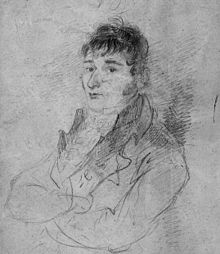art.wikisort.org - Artist
Luke Clennell (8 April 1781 – 9 February 1840) was a British wood-engraver and painter.
Luke Clennell | |
|---|---|
 Self-portrait, pencil on paper, c. 1810 | |
| Born | 8 April 1781 Morpeth, Northumberland |
| Died | 9 February 1840 (aged 58) Newcastle upon Tyne |
| Nationality | English |
| Education | Wood engraving by Thomas Bewick |
| Known for | Wood engraving, commemorative oil painting |
Notable work | The decisive charge of the Life Guards at Waterloo |
| Awards | Society of Arts gold palette British Institution premium |
| Patron(s) | Earl of Bridgewater |
Life
Clennell was born in Ulgham near Morpeth, Northumberland, the son of a farmer. He was apprenticed to the Newcastle upon Tyne wood-engraver Thomas Bewick in 1797. Between 1799 and 1803 he acted as Bewick's principal assistant on the second volume of his A History of British Birds. After completing his seven-year apprenticeship with Bewick he moved to London in 1804,[1] where he married a daughter of the copper-engraver Charles Turner Warren (1762–1823). Through his marriage he became acquainted with such book illustrators as William Finden and Abraham Raimbach.
He gained a reputation as a wood-engraver, and in May 1806 he was awarded the gold palette of the Society of Arts for a wood-engraving of a battle scene. He subsequently gave up engraving for painting. In 1814 he received from the Earl of Bridgewater a commission for a large commemorative picture, Banquet for the Allied Sovereigns, at the Guildhall, London. He experienced great difficulty in getting the more than 400 distinguished guests to sit for their portraits, suffered a mental breakdown, and spent some time in a mental asylum in Salisbury.[1]
Clennell was one of the competitors for the prize of one thousand guineas awarded by the British Institution for the best finished sketches connected with the victories of the British Army in Spain, Portugal and France, the works to be submitted to the British Gallery in January 1816.[2] Thirteen artists submitted works, and Clennell received one of the premiums for his picture entitled The decisive charge of the Life Guards at Waterloo.[1]
Clennell resumed work on the picture of the Allied Sovereigns in 1817, but suffered another bout of depressive mental illness, and his family found him throwing his palette and brushes at the canvas, "to get the proper expression." From then until his death in a Newcastle asylum in 1840 he was never well enough to work as an artist.[1]
- A Wayside Inn
- The Fair on the Thames
- The Press Gang
- Baggage Wagons in a Thunderstorm
References
- Uglow, 2006. pp. 350–352.
- Harrington, 1993. pp. 99–101.
Sources
- Bain, Iain. Clennell, Luke, 1781–1840 (Oxford Dictionary of National Biography).
- Stephen, Leslie, ed. (1887). . Dictionary of National Biography. Vol. 11. London: Smith, Elder & Co. pp. 35–7.
- Harrington, Peter (1993). British Artists and War: The Face of Battle in Paintings and Prints, 1700-1914. London: Greenhill. pp. 99–101.
- Story, Alfred Thomas. James Holmes and John Varley (London: R. Bentley, 1894).
- Uglow, Jenny. Nature's Engraver. A Life of Thomas Bewick. (London: Faber & Faber, 2006)
External links
- Works by Luke Clennell (Tate Online)
- Launching the lifeboat (1810 watercolour - South Shields Museum & Art Gallery)
- 18th-Century Blues: Exploring the Melancholy Mind, (Shipley Art Gallery)
На других языках
[de] Luke Clennell
Luke Clennell (* 8. April 1781 in Ulgham bei Morpeth; † 2. Februar 1840 in Newcastle-upon-Tyne) war ein englischer Holzschneider und Maler. Er galt seinen Zeitgenossen als der talentierteste von Thomas Bewicks Schülern. Zu seinen bekanntesten Arbeiten zählen die Illustrationen zu dem Gedicht The shipwreck von William Falconer. Für seine Gravur einer Urkunde für die Highland Society of London nach einem Entwurf von Benjamin West erhielt er die Goldmedaille der Society of Arts in London. Im April des Jahres 1817 brach bei ihm eine Geisteskrankheit aus, und er wurde in die Irrenanstalt in Newcastle eingewiesen. Bis zu seinem Tode 22 Jahre später änderte sich sein Zustand nicht.- [en] Luke Clennell
[fr] Luke Clennell
Luke Clennell, né le 8 avril 1781 à Ulgham (en) près de Morpeth dans le comté de Northumberland et mort le 9 février 1840 à Newcastle upon Tyne, est un graveur et peintre anglais.Другой контент может иметь иную лицензию. Перед использованием материалов сайта WikiSort.org внимательно изучите правила лицензирования конкретных элементов наполнения сайта.
WikiSort.org - проект по пересортировке и дополнению контента Википедии



